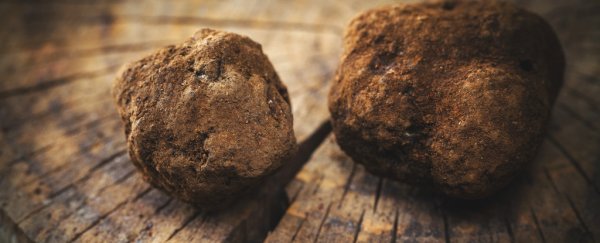The French Péridord black truffle, Tuber melanosporum, is one of the world's most prized and expensive delicacies - and now it's been cultivated the farthest north it's ever grown.
This was part of a deliberate program to see if truffle host trees can be grown in new regions as climate change threatens their natural habitat across France and the Mediterranean. The good news is, it worked, much better than expected, with the surprise appearance of a truffle nine years later.
Growing black truffles - the fruiting bodies of underground fungi - is a lengthy process at the best of times. They grow in the root systems of trees, forming a symbiotic relationship with their host.
As a result, the fungus becomes a sort of extension of the tree's root, receiving a constant supply of carbohydrate from the tree in return for supplying the root with minerals.
Truffles grow in soft, adequately moist, well-draining soils with high limestone content, almost exclusively in regions with a Mediterranean climate - northern Spain, northern Italy and southern France.
They also take years. A tree inoculated with truffle spores will take, on average, four to six years to produce its first truffle.
For years now, harvests of the Périgord truffle have been on the decline, as droughts in its natural habitat keep the soil from maintaining the moistness required for the fungus to thrive.
Black truffles are worth up to £1,700 per kilogram (US$1,016 per pound), and the black truffle industry is estimated to be worth £4.5 billion (US$5.9 billion) annually for the next 10 years, so researchers are trying to find ways to help them grow.
There have been successful attempts to grow T. melanosporum in Australia, New Zealand, China, America and South Africa, but, as a 2014 meta-analysis points out, the practices used are empirical and cannot reliably produce truffles.
Thus scientists from the University of Cambridge and truffle cultivation company Mycorrhizal Systems Ltd (MSL) combined forces to try and find a reliable way to grow the fungus in the UK.
"It's a risky investment for farmers - even though humans have been eating truffles for centuries, we know remarkably little about how they grow and how they interact with their host trees," said researcher Ulf Büntgen of Cambridge's Department of Geography.
"Since the system is underground, we can't see how truffles are affected by different environmental conditions, or even when the best time to water them is. There's been no science behind it until now, so progress is slow."
The host tree the researchers planted is a Mediterranean oak, which was inoculated with T. melanosporum spores before being placed in the ground in 2008. The surrounding soil was treated with lime to lower acidity.
Researcher Paul Thomas of the MSL said that the tree was mainly planted to monitor its survival. Although it was treated to encourage truffle production, the team never really thought the species could grow as far north as the UK.
They attribute its appearance to the same factor that's driving it out of its natural habitat - climate change.
"This cultivation has shown that the climatic tolerance of truffles is much broader than previously thought, but it's likely that it's only possible because of climate change, and some areas of the UK - including the area around Cambridge - are now suitable for the cultivation of this species," Thomas said.
The truffle itself, found by trained truffle dog Bella, weighed 16 grams (0.564 ounces) and has been preserved for posterity.
The research has been published in the journal Climate Research.
